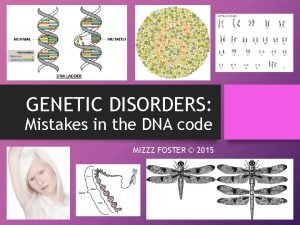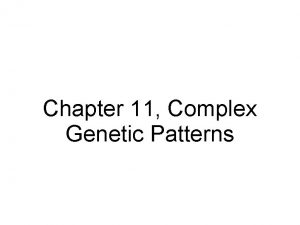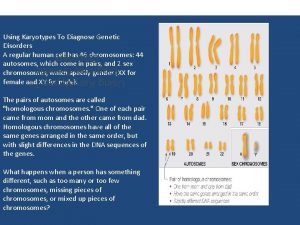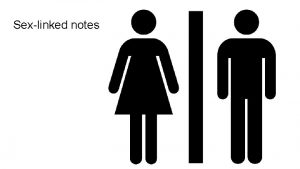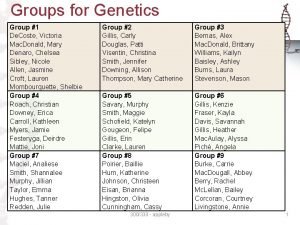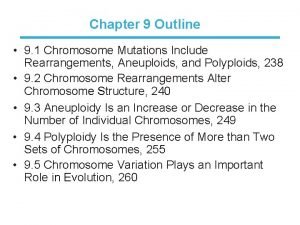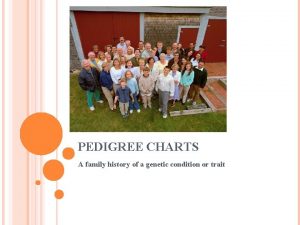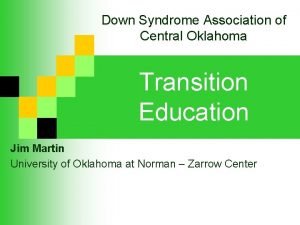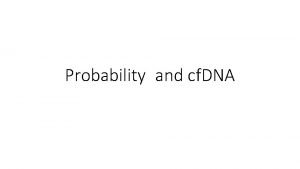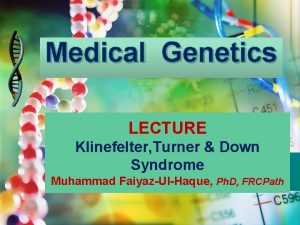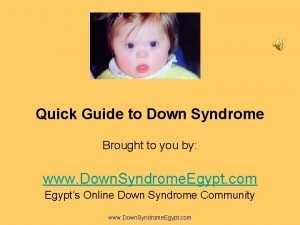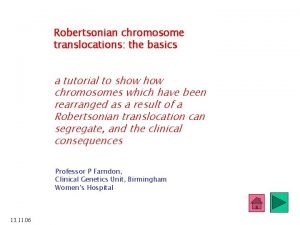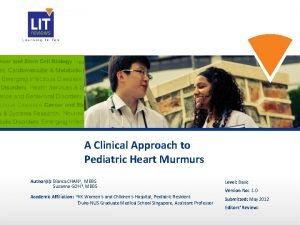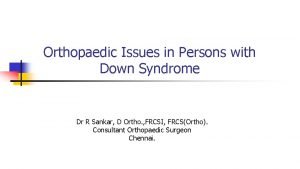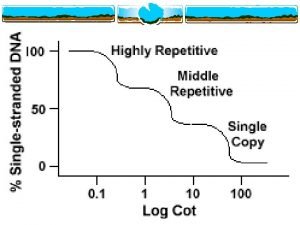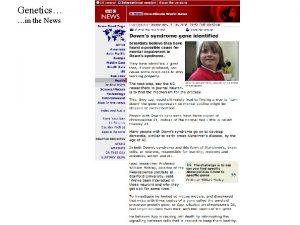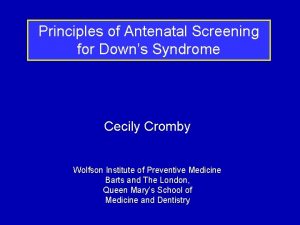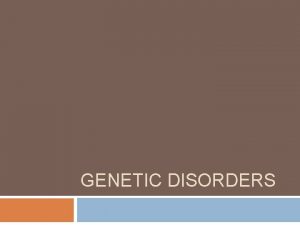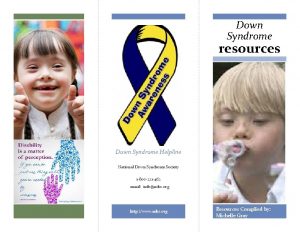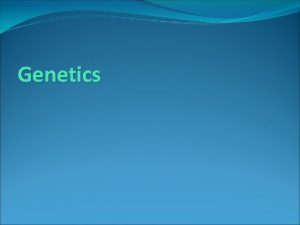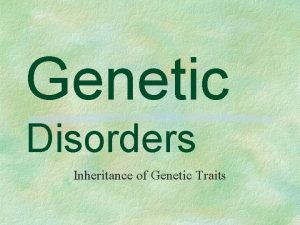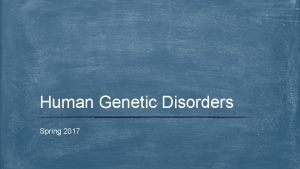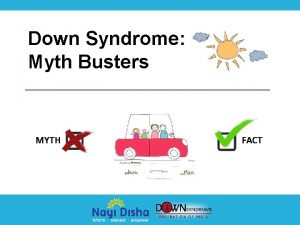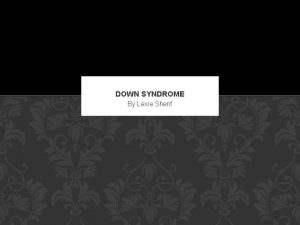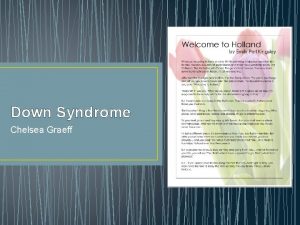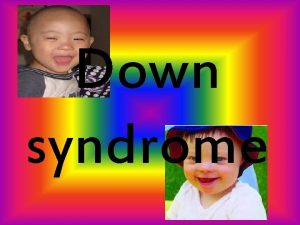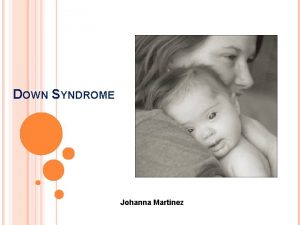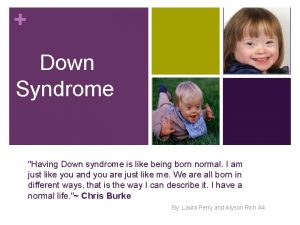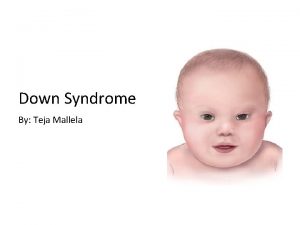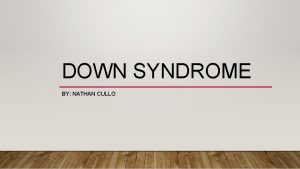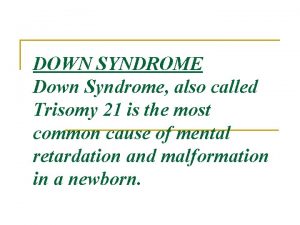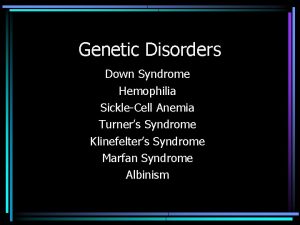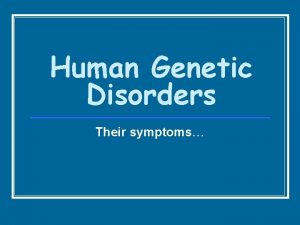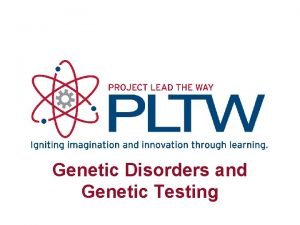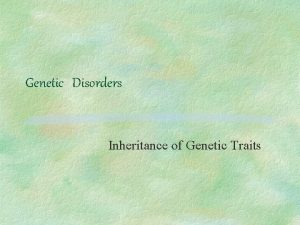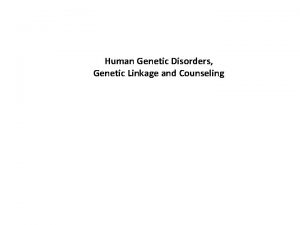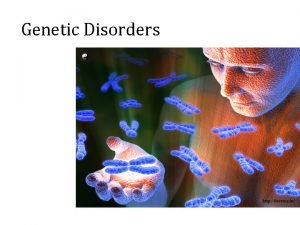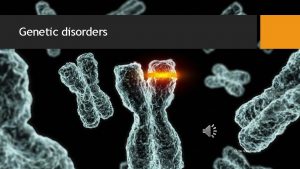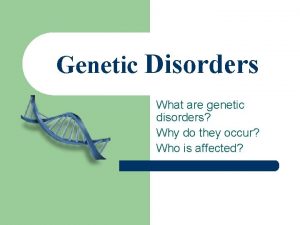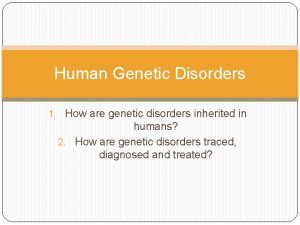Genetic Disorders G Crotts Spring 07 Down Syndrome

























- Slides: 25

Genetic Disorders G. Crotts Spring 07

Down Syndrome • Results from nondisjunction where a gamete has an extra or missing chromosome • Nondisjunction • Also called Trisomy-21 • Affects 1 in 691 babies born in the U. S. • Cause of nondisjunction occurring is unknown. • Woman age 35 and older have a significantly higher risk of having a child with the condition. Age 30 ---1 in 1, 000 chance Age 35 ---1 in 400 chance Age 42 ---1 in 60 chance

• • • All children tend to share certain physical features, regardless of race. These include: -flat facial profile -slant to eyes -single crease across center of palms -enlarged tongue -typically smaller stature Generally have mental disabilities that range from mild to severe. Heart problems and other medical problems can be common. Can be detected before birth using a karyotype http: //www. kidshealth. org/parent/medical/genetic/down_syndrome. html

Karyotype of Person with Down Syndrome

Triple X Syndrome (XXX or Trisomony X) • Females may be slightly taller • Increased risk of learning disabilities, delayed speech and language skills • 1/1, 000 newborn girls • It’s not inherited

Karyotype of Person with Triple XXX

Turner Syndrome XO • Females missing a sex chromosome • 1 in 2000 females • In infants: swollen hands and feet, wide webbed neck • In adults: drooping eyelids, incomplete development during puberty, short height, no periods, infertility • Growth hormones for height • Can lead to complications

Turner Syndrome

Karyotype of Person with XO

XXY-Klinefelter Syndrome • • • Males have an extra X chromosome Affects 1 in 500 to 1000 males Causes infertility Abnormal body proportions May prescribe testosterone

Karyotype of Person with XXY

XYY Syndrome • • • Males have an extra Y chromosome No unusual physical features No medical problems Learning disabilities Behavioral problems 1/1, 000 newborn boys

Karyotype of Person with XYY

Huntington’s Disease • Autosomal dominant trait- not on sex chromosomes, but on chromosome 4. • 1/10, 000 people. More prevalent in Caucasians. • A person with Huntington’s may not know they have it until they are 30 -50 years old. By that time they could have already passed it on to their children. • Too much of a particular protein is produced and it causes the brain to deteriorate and then leads to an early death. • No cure • The gene on chromosome number 4 contains too many repeats of the nucleotide sequence CAG. A normal person would have an average of 19 with the highest being 34, but a person with Huntington’s disease would have more than 40. • So the gene codes for too much of a protein called http: //www. hdsa. org

Huntington Video http: //www. about-dementia. com/images/dementia/Huntingtons. Pedigree. gif

Sickle Cell Anemia • Autosomal recessive • 1/1, 500 African Americans • More than 70, 000 Americans have sickle cell anemia. And about 2 million Americans - and one in 12 African Americans - have sickle cell trait (this means they carry one gene for the disease, but do not have the disease itself). • Affects a protein in red blood cells called hemoglobin, which carries oxygen. • Sickled cells can block blood vessels and the movement of blood and oxygen to body parts.

Sickle Cell Anemia http: //medicine. osu. edu/lend/Portfolios/0506/AR%20 Port/files/SICKLE%20 CELL%20 WEBSITE/images/sc 2. jpg

Cystic Fibrosis Autosomal recessive 1/ 2, 080 Caucasians Mucus clogs lungs, liver, and pancreas 30, 000 people in US have been diagnosed. Mutations in a gene on chromosome 7. Scientists don't know exactly why the CF gene evolved in humans, but they have some evidence to show that it helped to protect earlier generations from the bacteria that causes cholera, a severe intestinal infection. • One of the newest treatments for CF that's still being researched is an inhaled spray containing normal copies of the CF gene. These normal genes deliver the correct copy of the CF gene into the lungs of CF patients. • • •

http: //www. supplementnews. org/images/Cystic%20 Fibrosis. jpg

Tay-Sachs Disease • Autosomal Recessive • 1/1, 600 Ashkenazi Jews • Enzymes clear out fatty proteins that interfere with our growth. Because these enzymes get rid of these proteins we are able to develop hearing, vision, and movement. • A baby with Tay-Sachs disease is born without one of those important enzymes, called Hexosaminidase A (Hex A). So, as those fatty proteins build up in the brain, they hurt the baby's sight, hearing, movement, and mental development. • A baby born with Tay-Sachs develops normally in the first 3 to 6 months of life. During the next months - or even years - the baby will progressively lose the ability to see, hear, and move. A red spot will develop in the back of the child's eyes. The child will stop smiling, crawling, turning over, and reaching out for things. By the age of 2, the child may have seizures and become completely disabled. Death usually occurs by the time the child is 5 years old. http: //www. kidshealth. org/parent/medical/genetic/tay_sachs. html

Phenylketonuria Autosomal Recessive 1/18, 000 Abbreviated PKU. Newborns are given a test soon after they are born. A genetic disorder that is characterized by an inability of the body to utilize the essential amino acid, phenylalanine. The body can’t break it down. It builds up in the person’s blood and body tissues. If untreated causes mental disabilities and death. • Controlled by a very low phenylalanine diet. • High protein foods, such as: meat, fish, poultry, eggs, cheese, milk, dried beans, and peas are avoided. Instead, measured amounts of cereals, starches, fruits, and vegetables, along with a milk substitute are usually recommended. • • • http: //www. medhelp. org/lib/pku. htm

Hemophilia • Sex-linked or X-linked trait • Blood does not clot. Bruises and cuts are problematic, but internal bleeding can be fatal. • Males are much more likely to have the disease, while females are carriers. • 1/7, 000 people • Treated with a Clotting Factor Replacement Therapy. • If internal bleeding occurs, doctors can replace the missing clotting factor immediately. People with the disorder are trained in recognizing when they are bleeding internally.

http: //www. nhlbi. nih. gov/health/dci/Diseases/hemophilia_causes. html

http: //web. nmsu. edu/~gene 305/hemophilia. jpg

Muscular Dystrophy • Sex-linked or X-linked • Wasting away of muscles---including heart and lungs. Body is missing the genes to make the proteins that strengthen and maintain muscles. • Shortened life expectancy. • 1/10, 000 • Physical Therapy and Breathing treatments are used to assist people with this disorder as well as assistive technological devices. http: //www. kidshealth. org/parent/medical/bones/muscular_dystrophy. htm l
 Mizzz foster
Mizzz foster Chapter 11 genetic disorders concept mapping
Chapter 11 genetic disorders concept mapping Dominant vs recessive genetic disorders
Dominant vs recessive genetic disorders Using karyotypes to diagnose genetic disorders
Using karyotypes to diagnose genetic disorders Genetic programming vs genetic algorithm
Genetic programming vs genetic algorithm A gene pool consists of
A gene pool consists of Gene pool
Gene pool Genetic drift vs genetic flow
Genetic drift vs genetic flow Genetic programming vs genetic algorithm
Genetic programming vs genetic algorithm Summer autumn winter spring
Summer autumn winter spring Kim ki duk summer fall winter spring
Kim ki duk summer fall winter spring Is huntington's disease autosomal or sexlinked
Is huntington's disease autosomal or sexlinked Smallest organism
Smallest organism Edward syndrome
Edward syndrome Pedigree chart of down syndrome
Pedigree chart of down syndrome Down syndrome association of central oklahoma
Down syndrome association of central oklahoma Down syndrome ultrasound
Down syndrome ultrasound Monosomy disorders
Monosomy disorders Adults with down syndrome
Adults with down syndrome Unbalanced translocation down syndrome
Unbalanced translocation down syndrome Left upper sternal border
Left upper sternal border Down syndrome life expectancy
Down syndrome life expectancy Robertsonian translocation
Robertsonian translocation Low-set ears vs normal
Low-set ears vs normal Familial down syndrome
Familial down syndrome Down syndrome screening results
Down syndrome screening results
